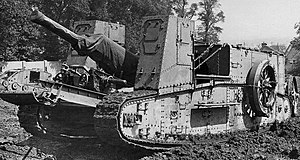| Gun Carrier Mark I | |
|---|---|
 British Gun Carrier Mark I fitted with a 60-pounder gun | |
| Type | Self-propelled artillery |
| Place of origin |
|
| Service history | |
| Used by | UK |
| Wars | World War I |
| Production history | |
| Designed | July 1916 |
| Manufacturer | Kitson & Co. |
| Produced | June - July, 1917 |
| No. built | 48 |
| Variants | Gun Carrier Crane, Gun Carrier Mark II (project only) |
| Specifications | |
| Mass | 28.45 t |
| Length | 9.75m |
| Height | 2.41 m |
| Crew | 4 + gun crew |
|
| |
Main armament | 60-pounder field gun or 6-inch howitzer |
| Engine |
Daimler petrol engine 105 hp |
| Suspension | Unsprung |
Operational range | 37.8 km |
| Maximum speed | 5.95 km/h |
The Gun Carrier Mark I was the first piece of self-propelled artillery ever to be produced, a British development from the First World War.
Development
During 1916 it became clear that in case of a breakthrough, the very purpose of the first tank, the Mark I, artillery would have great trouble following the advancing troops. Any successful offensive would therefore be in danger of stalling immediately. To solve this problem Major Gregg, an engineer working for the main tank producing company Metropolitan, Carriage, Wagon and Finance, proposed to build special mechanised artillery, using parts of the Mark I. The production of a prototype was approved on 5 June 1916; the actual design began in July. The first prototype was ready to participate in the Tank Trials Day at Oldbury on 3 March 1917. An order of fifty vehicles was given to Kitson & Co. in Leeds. Deliveries to the army started in June and ended in July.
Description
The vehicle bore little resemblance to the Mark I. The tracks weren't tall but low, almost flat. At the back a rectangular superstructure covered the Daimler 105 hp engine together with the transmission of the Mark I, the latter now in a reversed position. Sharing it were the vehicle commander, a mechanic and two gearsmen. The original double tail wheel of the Mark I, intended to aid steering and attached to the rear of the vehicle, was retained. The front was an open area with either a 60-pounder (5-inch) field gun or a 6-inch howitzer.
For transporting the gun only the wheels had to be removed from the gun carriage - these were attached to the side of the carrier until needed again. In theory, the field gun could be fired from the vehicle; in reality only the howitzer could be so used. Alternatively the guns could be unloaded through a pivoting cradle assisted by two winding drums driven by the engine. Above the front of the track frame at each side was an armoured cab for the driver on the left and the brakesman on the right. In the prototype these driving positions were directly in front of the superstructure; moving them forward improved visibility, but made communication very difficult - a problem as, in the Mark I, four men (including the gearsmen) had to cooperate to steer the tank.
Operational history
In July 1917 two Gun Carrier Companies were formed of 24 vehicles each. Probably none of them ever fired a shot in anger. As breakthroughs never materialised the vehicles were ultimately only used as supply tanks. It was calculated a single tank had the same carrying capacity as 291 human porters.
Variants

Two vehicles out of the order of fifty were finished as Gun Carrier Cranes, salvage tanks with a hand-operated crane in the front. The forward cabs were absent.
There was a project for a Gun Carrier Mark II. Early in 1917 a wooden mock-up was made of an improved type, carrying the gun at the back. A real prototype was partly built, but never finished, the sole result of the project being that the original type is now known as the Gun Carrier Mark I.
See also
| Wikimedia Commons has media related to Gun Carrier Mark I. |
References
The original article can be found at Gun Carrier Mark I and the edit history here.